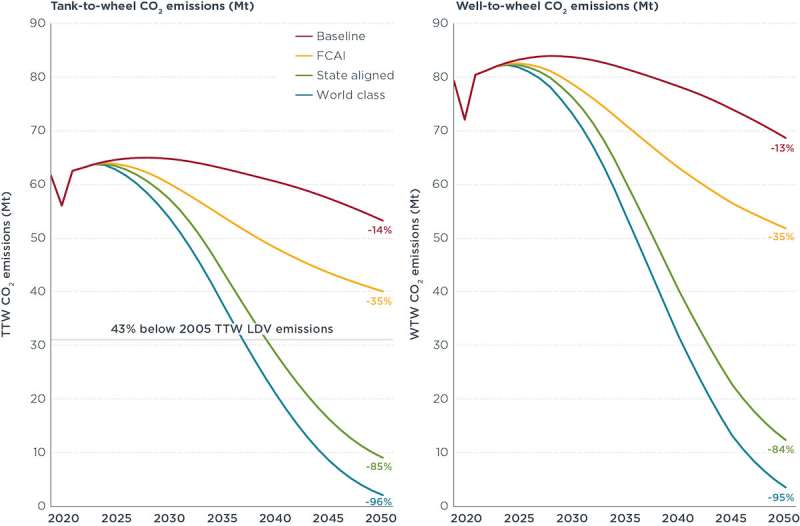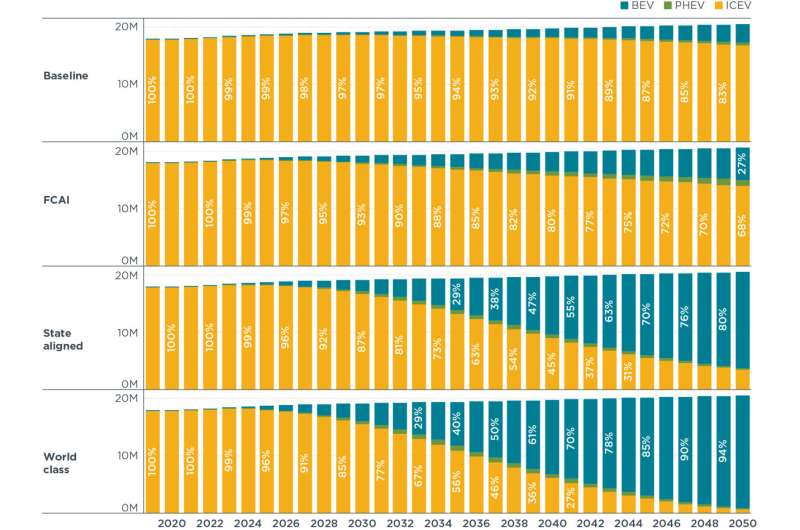Australia's opportunity to decarbonize light-duty vehicles with fuel efficiency standards

Australia can almost fully decarbonize its light-duty vehicle (LDV) fleet by 2050 by implementing fuel efficiency or carbon dioxide (CO2) emission standards like those already adopted in leading vehicle markets including the European Union, New Zealand, and the United States, a new study from the International Council on Clean Transportation (ICCT) finds.
Stringent, world-class standards starting in 2024 could reduce well-to-wheel CO2 emissions from the LDV fleet in Australia by 95% in 2050 compared to 2019.
Emissions from LDVs, which are passenger cars and light commercial vehicles, are nearly two-thirds of Australia's transport emissions and these were approximately 12% of the country's total greenhouse gas emissions in 2021, according to Australian government estimates.
ICCT's analysis shows that even implementing a less ambitious national standard that matches existing state-level electric vehicle targets would bring benefits: Well-to-wheel CO2 emissions from the LDV fleet would be 84% lower in 2050 than in 2019. However, this would also allow 165 Mt more CO2 emissions from 2019 to 2050 than if world-class standards are instead adopted.
"It's abundantly clear that emission standards would be effective in driving significant reductions in CO2 emissions from Australia's fleet, and they can promote both electric vehicles and emissions reduction from internal combustion engine vehicles (ICEVs)," said Zifei Yang, ICCT's passenger vehicles program lead and a co-author of the paper released today.
The study also analyzed the impact of the voluntary CO2 emissions targets set by Australia's Federal Chamber of Automotive Industries (FCAI).
ICCT's Roadmap model projections show that these targets, under their maximum stringency for new LDVs without adjusting for weights and credits, would allow ICEVs to dominate Australia's vehicle stock even in 2050. Additionally, the FCAI targets are not stringent enough to spur emissions reduction from ICEVs if state electric vehicle targets are met, and they might even allow emissions from ICEVs to increase.

"Preventing any backsliding in ICEV emissions performance is important because decarbonizing transport is a key part of achieving Australia's 2050 net-zero target," said Tanzila Khan, ICCT associate researcher and the study's lead author. "We urge policymakers to adopt the world-class standards starting no later than 2024."
Aligning with world-class emission standards would mean all new LDVs sold in Australia in 2035 are zero-emission vehicles. Such standards correspond to a fleet-average CO2 emissions target of 50 gCO2/km on the New European Driving Cycle in 2030, a 72% reduction compared with the emissions from the LDV fleet in 2019.
More information: Report: theicct.org/wp-content/uploads … -standards_final.pdf


















